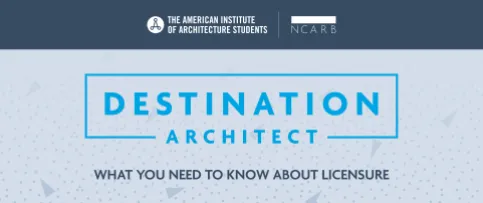To become an architect in the United States, you’ll need to earn a license from one of the 55 jurisdictions (also known as state licensing boards). While the requirements for licensure vary between jurisdictions, you’ll generally need to: 1) Earn a degree, 2) Gain and document professional experience, and 3) Pass the national licensing exam.
At NCARB, we recognize that everyone’s path to licensure is different. And while becoming an architect isn’t easy, the process should be inclusive. That’s why we’ve rolled out several alternative paths for candidates of all backgrounds. So whether you’re a recent college grad or an experienced designer, we’re here to help you reach your career goals.
Ready to get started? Here’s a quick guide to earning your first architecture license. In part two of this series, we’ll cover alternative options for U.S. architects looking to earn a reciprocal license.
Research Your Jurisdiction
Since each jurisdiction sets its own requirements for licensure, it’s a good idea to explore our licensing requirements tool. Simply choose the jurisdiction where’d you like to earn your first license (also known as initial registration) to learn about the specific education, experience, and examination requirements.
Earn a Degree
In most jurisdictions, you’ll need to earn a degree from a program accredited by the National Architectural Accrediting Board (NAAB)—a Bachelor of Architecture, Master of Architecture, or Doctor of Architecture. A handful of licensing boards accept non-accredited degrees, and some allow candidates to document additional experience in lieu of meeting the education requirement.
Report Experience
Once you graduate high school, you can start earning real-world experience through the Architectural Experience Program® (AXP™). Developed by NCARB, the program is required by most U.S. jurisdictions and provides a framework to guide you through gaining and documenting experience. Keep in mind, some jurisdictions require additional experience beyond the AXP.
To report experience, you’ll need to establish an NCARB Record, which will become a detailed, verified account of your education, experience, and examination history.
There are two ways to report your AXP experience:
- Hourly reporting. The majority of licensure candidates complete the AXP by documenting a minimum of 3,740 hours across six experience areas. To earn full credit, you’ll need to submit your experience within the time limit established by the reporting requirement.
- AXP Portfolio. This option is for seasoned designers with experience that’s at least five years old. Through the portfolio, you’ll submit exhibits of work—documents, PDFs, images, or other files—that demonstrate your ability to perform the tasks identified in the AXP.
Pass the Licensing Exam
The Architect Registration Examination® (ARE®) is a multi-division exam used to assess your knowledge and skills. Developed by NCARB, the exam is required by all U.S. jurisdictions, and you can usually start testing after college. A handful of jurisdictions require candidates to pass an additional exam on local statutes or geological conditions.
Apply for a License
After you’ve met your jurisdiction’s education, experience, and examination requirements, you can submit an application for initial licensure!
Are you a U.S. architect looking to earn a reciprocal license? Check out part two of this blog series to learn about our alternative options.



